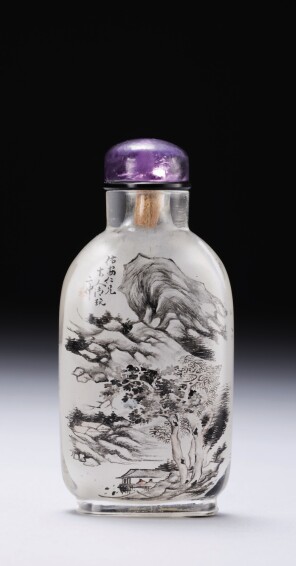- 6
AN INSIDE-PAINTED GLASS 'LANDSCAPE' SNUFF BOTTLE DING ERZHONG, 1897
Description
- glass
Provenance
Collection of Eric Young.
Sotheby's London, 3rd March 1987, lot 148.
Exhibited
Kleine Schätze aus China. Snuff bottles—Sammlung von Mary und George Bloch erstmals in Österreich, Creditanstalt, Vienna, 1993, p. 10.
Literature
Hugh Moss, Victor Graham and Ka Bo Tsang, A Treasury of Chinese Snuff Bottles: The Mary and George Bloch Collection, vol. 4, Hong Kong, 2000, no. 546.
Condition
"In response to your inquiry, we are pleased to provide you with a general report of the condition of the property described above. Since we are not professional conservators or restorers, we urge you to consult with a restorer or conservator of your choice who will be better able to provide a detailed, professional report. Prospective buyers should inspect each lot to satisfy themselves as to condition and must understand that any statement made by Sotheby's is merely a subjective, qualified opinion. Prospective buyers should also refer to any Important Notices regarding this sale, which are printed in the Sale Catalogue.
NOTWITHSTANDING THIS REPORT OR ANY DISCUSSIONS CONCERNING A LOT, ALL LOTS ARE OFFERED AND SOLD AS IS" IN ACCORDANCE WITH THE CONDITIONS OF BUSINESS PRINTED IN THE SALE CATALOGUE."
Catalogue Note
The superbly painted landscape of the other side is a transitional one between the style of Sale 2, lot 54 and the much more abstract Sale 9, lot 193. Although the style of painting is similar here to the first, with its more integrated linear approach where lines blend into each other to form the mass of the mountains, the composition is becoming much more abstract. Ding has now broken down his mountain forms into balancing elements of dark and light, large and small. This is particularly noticeable in the use of the smaller rounded rocks that are dotted about the landscape more as a formal element than as small boulders, although they serve as both.
In what is essentially a monochrome landscape painting, despite the coloured robes of the figures, Ding has added one small wash of blue high on the left-hand side of the group of trees above the red-robed figure. It cannot have been accidental and is so strange an anomaly in an otherwise ink landscape that it can only represent breath-taking confidence.
There appears here the studio name Shiqishu meihua shanfang, (Mountain Abode of Seventeen Prunus Trees), which was first used by Ding in the previous year, 1896. It seems that Ding kept this studio name when he moved from Beijing to Nanjing, probably in 1900, since he continued to use it on bottles as late as 1906.

